Key Takeaways
- Experiences gained from existing digital scholarship centers can help uninitiated institutions better launch their own efforts and thereby increase support for the research, teaching, and learning needs of their campus communities.
- A key attribute that distinguishes digital scholarship centers from more traditional research institutes is that they are service organizations, staffed by individuals with specialized skills who support work in the digital environment.
- Case studies from Brown University and McMaster University illustrate two approaches to digital scholarship centers as envisioned by different higher education communities, the first approaching maturity and the second still new.
Joan K. Lippincott is associate executive director, Coalition for Networked Information; Harriette Hemmasi is university librarian at Brown University; and Vivian Lewis is university librarian at McMaster University.
Overview: Digital Scholarship Centers
Joan Lippincott
To accomplish their work, academic researchers increasingly rely on digital tools and large data sets, such as data visualization in the environmental sciences, data mining a large corpora of texts in the humanities, and developing GIS or other geolocation data representations in the social sciences. Librarians and information technologists often provide consultation or might even join the research team in these collaborative digital research projects.
An increasing number of universities and colleges are establishing digital scholarship centers to support these high-end digital projects, which serve research, teaching, and learning. Digital scholarship centers focus on relationships, extending the ways in which librarians and academic computing professionals relate to and work with faculty (and often students) and their scholarly practices. These centers serve an array of disciplines in the humanities, social sciences, and sciences. Most institutions have one center serving all disciplines; a few offer separate, specialized centers for various disciplines; and some serve only a single broad area, such as the humanities.
Here, we examine centers that go by a variety of names — including digital scholarship center, digital scholarship lab, and scholars' lab — but that nonetheless share common features. These centers are generally administered by a central unit, such as the library or IT organization; serve the entire campus community (including undergraduates, graduate students, and faculty); and address the needs of a range of academic departments and programs.
Although sometimes confused with digital scholarship centers, digital humanities centers are often specialized research centers led by a group of faculty and serving only select disciplines rather than a broad campus community. Also, libraries often play only a peripheral role in digital humanities centers.1 In contrast, libraries or IT organizations have a key role in digital scholarship centers.
Digital scholarship centers are not exclusive to large research universities. As the box below shows, the Coalition for Networked Information (CNI) membership meetings feature digital scholarship programs from a range of institutions, including small colleges. Most U.S. universities and colleges do not yet have a digital scholarship center, and most existing centers were established only in the past few years. We expect to see an increasing number in the near future. Meanwhile, centers in their early stages are experimenting with various services and staffing models as they develop partnerships and engage with various researchers; even well-established centers frequently adjust their priorities and services as the nature of digital scholarship and those engaged with such work on campus evolves.
CNI Presentations on Digital Scholarship Centers
Recent Coalition for Networked Information meetings included presentations on digital scholarship centers from various institutions. Following is a list, along with a link to each presentation.
- Brown University and University of Nebraska
- Brown University and McMaster University
- Columbia University
- Occidental College and other liberal arts colleges
- University of Notre Dame and University of Miami
- University of Oregon
- University of Richmond
- University of California, Los Angeles (UCLA)
- University of Virginia
Digital scholarship centers can build institutional capacity to address emerging and future scholarship needs. The rationale for developing such a center includes to
- provide a support mechanism for the growing areas of e-research and digital scholarship;
- bring together expensive technologies (and services to support their use) to serve the entire campus; and
- let students explore digital technologies in their research when such resources — whether technologies or advisory support — are unavailable in their departments.
Services and Staffing
A key attribute that distinguishes digital scholarship centers from more traditional research institutes (such as digital humanities centers) is that they are service organizations, staffed by individuals with specialized skills, who support work in the digital environment. This characteristic reflects the nature of university libraries and IT units, which generally offer services to the campus community and have highly trained staff to work with various constituencies. Digital scholarship programs offer an array of services, frequently including both one-on-one consultation and workshops on:
- Planning digital projects
- Using specialized software and tools
- Developing metadata
- Understanding relevant standards
- Addressing intellectual property concerns
- Planning for long-term preservation
- Digitizing analog materials
- Considering options for presenting or publishing completed projects
Some centers develop or point to existing online tutorials to provide background on common topics. At this point, a few centers are offering or partnering with an academic department to offer credit courses and certificate programs. Centers such as McMaster University (described below) and the University of Virginia's Scholars' Lab, have developed graduate student fellowship programs that create a cohort of students who interact with each other and lab staff and form communities of practice.
Center activities are not limited to research; in some cases, faculty are developing projects that include components to be used in teaching and learning, either by directly involving students in content creation or by formulating activities and curricula for use in conjunction with the digital projects they produce.
Digital scholarship center staff have a range of backgrounds and skill sets. Many centers include library/information professionals who are experts in scholarly communication, intellectual property, data curation, digitization, and digital preservation. Centers frequently have staff members with skills to support web and applications development, GIS, data visualization, and video production. Further, some centers include instructional designers on staff, have academic department faculty serve as part-time or full-time co-directors or staff members, and/or include Council on Library and Information Resources (CLIR) Fellows, who are postdocs working at the intersection of academic libraries and educational technologies.
Facilities and Equipment
Whether a digital scholarship center needs a dedicated facility or can be a distributed set of physical spaces and services — or even a virtual service — are open questions. A physical center that brings together specialized equipment and services in one convenient place has the advantage of visibility and provides a venue for an array of programming, including workshops, guest lectures, and displays of completed projects. In other cases, an office or set of offices might serve as the hub for center staff, while equipment and services are dispersed in physically separate media production areas, GIS facilities, data visualization labs, and makerspaces. Many existing digital scholarship centers include
- a service desk for initial interactions,
- consultation areas,
- staff offices,
- production or lab space with appropriate equipment,
- collaborative work spaces,
- large screens for use during project development and to display completed work,
- seminar or classroom space, and
- exhibit areas.
Equipment and software capabilities can include video production, audio labs, digitization labs, data visualization studios, and 3D printers.
Implementation
To illustrate both the commonalities and differences in digital scholarship center implementations, we offer the following case studies of the Brown University Center for Digital Scholarship (and its forthcoming Digital Studio) and the McMaster University Lewis & Ruth Sherman Centre for Digital Scholarship. The Brown case shows the evolution of a center over time; at McMaster, the center is relatively new. Both centers serve a broad array of academic disciplines and incorporate programs that enrich teaching and learning along with research support. In each case, the physical space, technologies available, and highly skilled staff play essential roles. The case studies also illustrate the importance of tailoring a digital scholarship program to the needs of the institution; there is no "one size fits all."
Case Study: Brown University
Harriette Hemmasi
Digital scholarship has deep roots at Brown. Starting in the mid-1960s, faculty here have carried out pioneering work in computational linguistics, hypertext, hypermedia, web authoring, and the encoding of early printed texts. These projects helped inform important new approaches to research and introduced fundamental shifts in the university's academic programs; the result was some of the nation's earliest examples of innovative, interdisciplinary scholarship.
Brown featured one of the first groups designated to provide humanities faculty support for developing and using advanced IT in academic research, teaching, and scholarly communication. Originating in 1994, the Scholarly Technology Group (STG) was led by Allen Renear, Geoffrey Bilder, and Elli Mylonas. Together, they pursued a visionary mission for more than a decade by exploring new technologies and practices, developing specialized tools and techniques, and providing consulting and project management services to academic projects.
Center for Digital Scholarship
Several years ago, STG staff were incorporated into the Brown University Library; from this union, the Center for Digital Scholarship (CDS) was born. CDS has become a focal point for advancing digital library methods and tools and a center of expertise at Brown for the digital humanities and other domains involving similar processes, such as metadata work, repository services, data curation, and visualization. With the library's commitment to strategically repurposing vacant staff lines, CDS has grown to include two digital humanities librarians, a social science data librarian, a scientific data management consultant, a data visualization specialist, an imaging and metadata manager, and a digital repository manager.
Interfacing with students and faculty as they increasingly engage in nontraditional methods of teaching, learning, and research, CDS builds infrastructure, interfaces, tools, and systems and works with members of the Brown community to develop new digital projects and collections. Through its broad-scale support of digital information and scholarly activities, CDS is often involved in close collaboration with other technology-based service and academic centers across campus.
Brown's Digital Spaces
Over the past decade, Brown has invested in several labs and modern gathering, production, and presentation environments that support media-rich, collaborative, interdisciplinary faculty and student projects and promote the university's increasingly technologically sophisticated research and pedagogy. Prominent among these spaces is the Center for Computation and Visualization (CCV), which includes a high-performance computing and data storage platform, as well as support for a new world-class computer-assisted virtual environment (CAVE) that will enable innovative computational science as well as visualization and virtual reality research across the disciplines (see figure 1). Other important technologically equipped spaces on campus include the Computing and Information Systems'multimedia labs, which serve as both production and teaching spaces (see figure 2), and the Granoff Center for the Creative Arts, which promotes collaboration between and among the arts, sciences, and humanities (see figure 3).
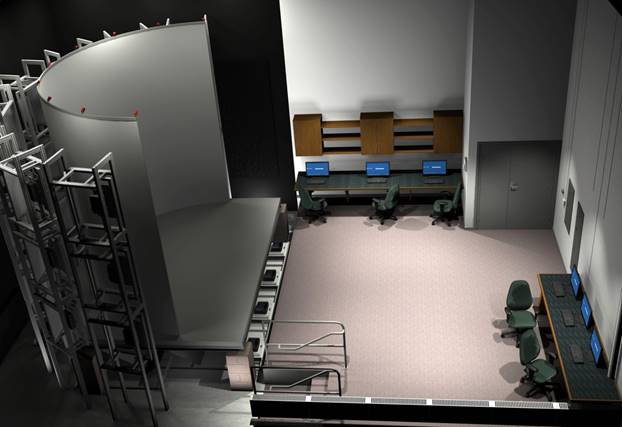
Figure 1. Brown University's computer-assisted virtual environment (CAVE)

Figure 2. The Computing and Information Systems' multimedia labs
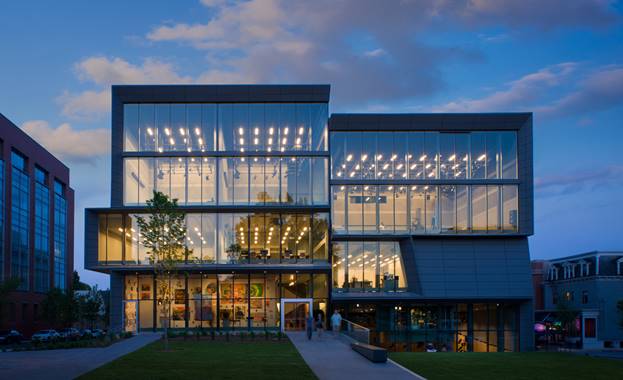
Figure 3. The Granoff Center for the Creative Arts
While developing the Garibaldi panorama project (video, 7:07 minutes), the library identified the need for a widely accessible, stable, and easy-to-use high-definition video wall that could interact sequentially or simultaneously with single and multiple data objects at resolutions well beyond what was visible on a standard desktop or digital projector. Consultations with faculty across disciplines — from the biological, planetary, and geosciences to computer and social sciences to literary and visual arts — confirmed this as a campus-wide need, and faculty were uniformly enthusiastic about the potential benefits of the wall's multipanel control system for teaching and research. After a successful round of fundraising, the Patrick Ma Digital Scholarship Lab (DSL) opened in fall 2012, featuring a video wall consisting of 12 LED displays that created a 7 x 16-foot high-definition display, with a combined total of more than 24 megapixels (see figure 4). Complementing and greatly extending the university's other technology offerings, this centrally located, highly functional space is outfitted with surround sound and videoconferencing capabilities and is in constant use by classes, workshops, individuals, and groups.
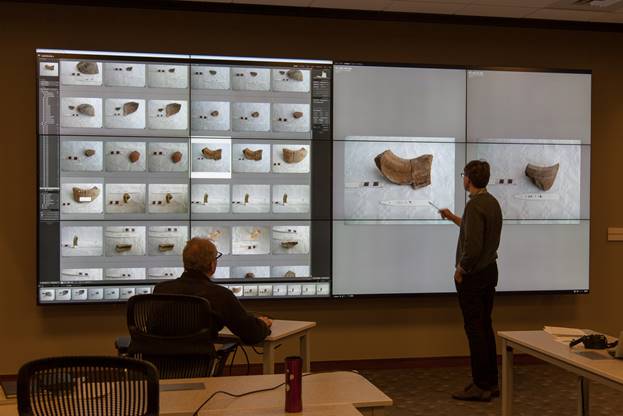
Figure 4. Archeologists use the video wall in the Patrick Ma Digital Scholarship Lab
The DSL provides a unique research, teaching, and presentation space that is ideal for visualizing, analyzing, and interacting with all types of digital content in a highly collaborative environment. However, it does not easily lend itself to
- extended sessions in which scholars need sufficient individual space and solitude to pursue the intricate, progressive steps of project development and design;
- one-on-one or group consultation sessions;
- the creation and editing of presentations and digital media objects;
- learning a new tool; or
- exploring how to integrate traditional resources into novel forms of research and scholarship.
To fulfill these and other emerging needs, the library recently applied for and received external funding to create a companion space to the DSL, the Digital Studio (see figure 5). Scheduled to open in the fall of 2015, the Digital Studio will provide a much-needed intellectual hub on campus to explore, develop, and promote new methods and forms of scholarship across the disciplines. The studio, with its high-end individual and group workstations, seminar room, private consultation rooms, and small group collaborative spaces, will help forge connections across the faculty's common strengths, which in turn will
- raise awareness and create otherwise unformed intersections across research and teaching interests, and
- foster new models of inquiry and interchange among faculty and students.
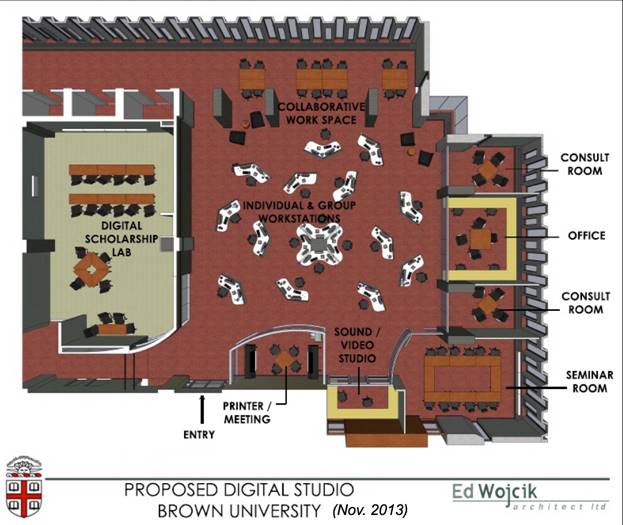
Figure 5. The proposed Digital Studio floor plan
CDS staff will be readily available to assist with project design and implementation, digital imaging, data curation and management, archiving and repository services, and instruction in digital scholarship's basic methodologies and practices, as well as to advise scholars at all levels throughout the various stages of experimentation, iterative versioning, and eventual publication and dissemination of their scholarly output. The Digital Studio and its accompanying Digital Scholarship Lab are essential, dynamic ingredients in Brown's emerging digital ecosystem, enabling an important transition from project to program.
Digital Projects at Brown
Digital environments, both physical and virtual, offer many exciting opportunities for integrating new dimensions into the creation, presentation, and dissemination of scholarly products. Compelling digital scholarship is often as much about interaction, process, and discourse as it is about presenting an argument. The best examples of new scholarly forms not only creatively apply digital tools and methodologies to communicate the scholar's objectives, but they also encompass an intelligent, artful intertwining of scholarly inquiry, analysis, and judgment.
The Theater that Was Rome website, codeveloped by the CDS and Brown Italian Studies Professor Evelyn Lincoln, is a long-standing research and teaching site that reunites text and images from specialized (and often very expensive) books from the 16th–18th centuries. Depicting Roman architecture, decorative arts, maps, and engineering, these books were frequently printed multiple times and subsequently dissected and sold page by page. Not only does this site collocate and provide access to many such items, it also supplies a corresponding base of bibliographic information, historical documentation, and critical interpretation. Students, faculty, and library staff work together to index individual artists, engravers, and publishers from across the collection, and they enrich the primary sources by adding page- and image-level metadata to many images, reuniting pages with books and images with their artists, engravers, and publishers.
MonArch: Monastic Archaeology is another Brown faculty-library collaboration; it combines essays, field and spatial data, databases of objects, timelines, and temporal visualizations to present a broad overview of activities and changes over time at the medieval monastery of St. Jean-des-Vignes in Soissons, France. An outgrowth of Brown Professor Sheila Bonde's archaeological fieldwork, the site gives readers a sense of daily life at the monastery by charting residents' movements and daily schedules. Data representing text, site plans, and artifacts throughout the website are closely linked, allowing prose about one aspect of monastic life to link to external databases and visualizations that provide different views of the supporting evidence.
The library is also working with faculty in the creative arts to preserve and publish art and art scholarship that heavily use digital media. In the initial phase, CDS staff are storing digital objects related to artistic performances and exhibitions in the Brown Digital Repository (BDR) and experimenting with how to present these works in ways that are both evocative and informative. Two examples of digital art works from this project are Aphasia and Enlarged to Show Detail, created for the CAVE Writing workshop.
The BDR lets data curators group and relate objects in ways that reflect and preserve the context in which they were created. Each piece is an amalgamation of source code, media files, text documents, and a range of idiosyncratic and uncommon file types, which are bound together as archival units within the repository. Scholars can retrieve these materials for examination and reuse, with an understanding of how they were related when the piece was first designed. This ability to establish complex semantic relationships between content, regardless of its form, affords scholars considerable flexibility; it lets them both conceive new forms of scholarship and "publication" that have the potential to offer novel and nuanced arguments using digital media, and ensures that their works' important dimensions are preserved as technologies change.
Case Study:McMaster University
Vivian Lewis
The establishment of the Lewis & Ruth Sherman Centre for Digital Scholarship at Canada's McMaster University in Hamilton, Ontario, cut a different path. McMaster is one of Canada's most research-intensive universities, with recognized strengths in numerous fields, including global health, water, transportation, and materials research. The university has erected a strong infrastructure to support the research enterprise and offers solid support for research and advanced computing. McMaster's Research & High-Performance Computing Support Group, led by Ranil Sonnadara, reports directly to the VP of Research and International Affairs and provides desktop and server system administration, application development, data visualization services, data analysis programming, database design, management services for technical personnel, and design and consulting services for the university's research community (see figure 6). This group also provides assistance with applications for funding and offers a core, scalable IT infrastructure for research that scholars and teams can leverage as needed. McMaster University is a leader in Shared Hierarchical Academic Research Computing Network (SHARCNET), Canada's largest advanced and high-performance computing consortium, with 17 partner institutions working to establish the environment and human resources required to support world-class computational capacity. The university is also a key member of the Southern Ontario Smart Computing Innovation Platform (SOSCIP).
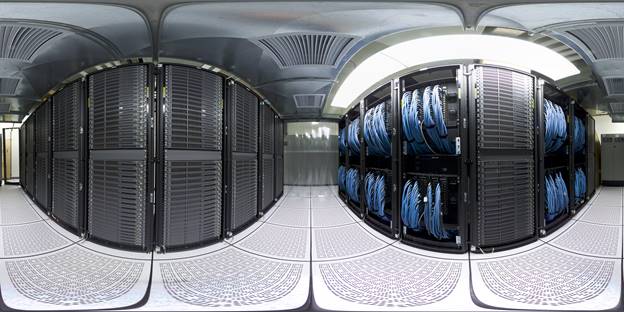
Photo by Sergey Mashchenko
Figure 6. Research and high-performance computing facility
A Center for the Future
Despite the strength of McMaster's research enterprise, digital scholarship as a recognized and discrete slate of research practices had limited campus visibility. The Lewis & Ruth Sherman Centre for Digital Scholarship, which opened in November 2012, was built in anticipation of scholars adopting new research methodologies. Talented new researchers interested in harnessing computational power in innovative ways were coming to McMaster, but the large cadre of practicing digital scholars had yet to be built. Recognizing this, the then-current university librarian and dean of Humanities decided to push ahead of the curve — to build something that traditional researchers might not fully embrace the day the ribbon was cut, but who would come to recognize the value proposition for in the future.
The center's physical location within the university library made good sense. The library was already home to the award-winning Mills Learning Commons, the Lyons New Media Centre (featuring media editing suites, a green screen, and a video wall; see figure 7), and a strong Maps, Data & GIS program. The library also provided space for and partnership with key campus research groups, including the Statistics Canada Research Data Centre, the McMaster Health Forum, the Bertrand Russell Research Centre, and the McMaster Institute for Innovation and Excellence in Teaching and Learning.
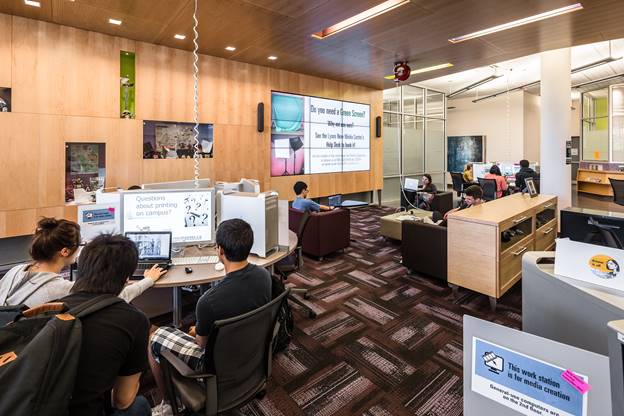
Photo by Ron Scheffler for McMaster
Figure 7. Lyons New Media Centre
Scope and Objectives
The center's scope took many forms during the planning stages. Early champions saw it as clearly grounded in the humanities, but were adamant that it support all disciplines. The use of technology to support new forms of scholarship was viewed as liberating research from the boundaries of geography or discipline.
Founding documents set many objectives for the Sherman Centre, including to
- promote library and researcher resource sharing,
- deliver customized and scalable IT infrastructure,
- provide technical support and consulting services,
- provide physical meeting and work spaces, and
- take the lead in several archival and access initiatives.
The Sherman Centre has taken a "design-build" approach: Spaces were rendered with maximum flexibility in mind — with minimal enclosed spaces and with a strong focus on moveable furniture and adaptable technology. Design work has continued long after the center was officially opened: Key service and space components have been added as the needs of the campus community have become more clear. Staff members are now taking the center in new directions as campus awareness increases and new faculty members find their way in. Indeed, if we were rewriting the Sherman Centre's objectives today, we would probably include a stronger emphasis on embedding digital scholarship skills into the campus teaching and learning mission; such skills have become critical for scholars who hope to play new roles within the academy.
Early on, we realized that the Sherman Centre's future — along with that of digital scholarship in general — rested with the university's graduate students and early career faculty. These new scholars were receptive to experimenting with new approaches. Many were interested in alternative academic careers and recognized that digital scholarship skills gave them a competitive edge in the new academy. We also recognized that graduate students, in particular, can have a tremendous influence on their faculty supervisors and that, over time, new approaches that graduate students learned could find their way into faculty labs. And, of course, graduate students themselves often join the faculty ranks later in life. A researcher who developed deep digital scholarship skills in his or her early career could be on the vanguard of new methods later. Thus, the Sherman Centre was not serving an established collection of self-identified digital scholars — it was growing its own.
Staff Expertise
Building a core staff expertise set was recognized as absolutely critical to the Sherman Centre's success. The model, incorporating both an academic director drawn from the faculty ranks and an administrative director drawn from the university library, has set the center on a good path from opening day. Academic Director Sandra LaPointe (Philosophy) focuses her attention on engaging the academic faculties in the Sherman Centre's life. Administrative Director Dale Askey (associate university librarian for Library & Learning Technologies) oversees the delivery of services and sets the resource allocation priorities.
As a clear indicator of its strategic priority, the library relocated four existing staff positions into the Sherman Centre. Those positions are the digital scholarship librarian, digital repository librarian, a programmer, and (until recently) a postdoctoral fellow. Like the scholars they work with, the Sherman Centre staff members are inherently curious and are building their own toolkits as new, beneficial projects appear.
Creating the Space
The space itself has also evolved. Early on, staff members aspired to build capacity for digital scholarship on campus by creating opportunities for faculty and researchers to, as Askey suggests, "bump into each other." The space includes soft seating (figure 8) and public presentation space, work spaces assignable to individuals and small teams, a meeting room, great art (figure 9), and a popular coffee bar.
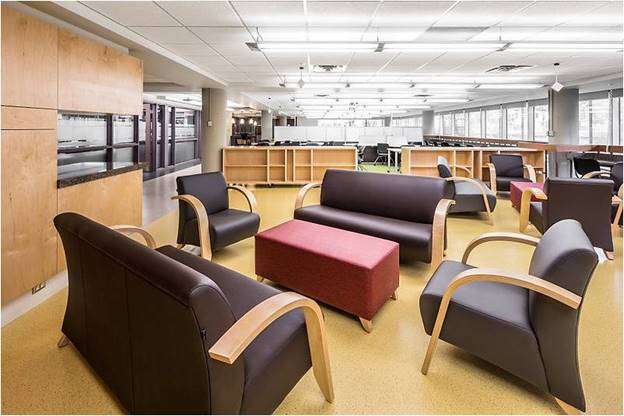
Figure 8. Sherman Centre seating area
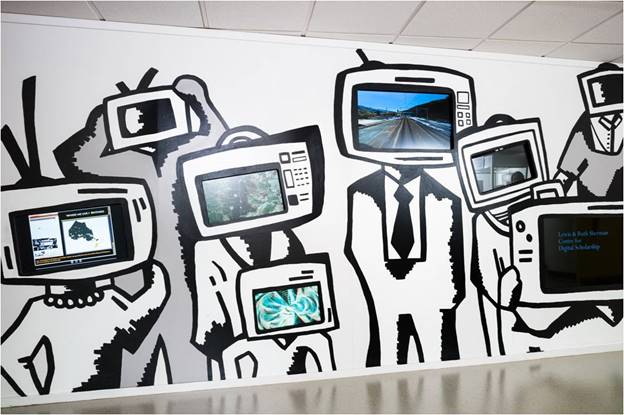
Photo by Ron Scheffler for McMaster
Figure 9. Sherman Centre Media Wall created by student artist Katrina Camillen
Adjustments have been made since the construction crews left. Plans are underway to break up the open space to create more capacity for simultaneous use. Such "settling" is expected. Also, the makerspace has become a focal point of the Sherman Centre (see figure 10). The sandbox environment gives visitors an extraordinary opportunity to roll up their sleeves, take things apart, and (sometimes) put them back together. The makerspace has captured significant interest, and the local public library has expressed interest in incorporating the university experience in their own public implementation.
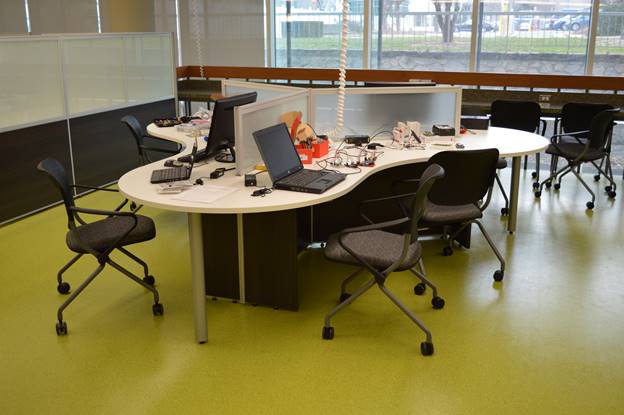
Photo by Matt McCollow
Figure 10. An early image of the Makerspace
Sherman Centre Projects
Although still in its early days, great work is happening in the Sherman Centre. The facility currently supports nine active research projects. In addition, three graduate students — Hayley Goodchild, Kellen Kurschinski, and Daniel Schmidtke — were recently identified through competition as Sherman Centre Graduate Fellows. Each received space in the center, access to expertise, and a small stipend.
The project work in progress reflects a range of subjects. Goodchild is currently working on an environmental and social history of dairy farm industrialization in Ontario from 1860–1930. Her work includes the creation of digital maps and a database that shows the distribution of various dairy factories throughout the period. In another project, Christopher Handy is extracting digital data from handwritten Sanskrit manuscripts using simple genetic algorithms. Although his project is quite specialized, his foundational ideas are expected to apply to a variety of contexts.
In recent months, the Sherman Centre has taken on a new prominence in the university's teaching mission. Center staff are currently teaching a for-credit course centered on the new makerspace to students in the Arts & Science and Integrated Science programs. This summer, the library hopes to hire a new postdoctoral fellow, this time focused on building a digital humanities curriculum and learning objects. The results of such an exploration are yet to be determined — but the opportunities for campus dialogue should be extremely positive.
Lessons Learned
Looking back over the past 18 months, we have four observations. First, we have learned the critical importance of clearly defining the Sherman Centre's scope and purpose for the campus community. Understanding of digital scholarship's boundaries is still relatively low on all of our campuses. Work in the center falls outside traditional norms for how research is done — the norm being that research is a solitary activity, with no "bumping around" required. In terms of libraries, it is definitely outside the norm. Libraries are traditionally very transaction-based: we count the number of people who enter our doors, ask us research help questions, and attend instruction sessions. We have no mental model for tracking activity within a digital scholarship center, which is inherently more relationship-based.
Second, we've learned that the relentless demand for physical space on campus creates pressure on our new center. Faculty members and graduate students are always looking for a place to run their experiments and relocate their staff. We often find ourselves having to turn people away when their work is not advancing the digital scholarship agenda. Saying no is not easy, but it must be done to protect the center's integrity.
Third, we've learned of the vital need for patience — both individual and organizational. Digital scholarship centers are not created in a day or even in 18 months. Building a good center requires patience on the part of our senior university administrators, faculty, and staff. A digital scholarship program is built on relationships, as well as on the careers of its scholars. Centers evolve as junior faculty members incorporate digital scholarship into their research and then rise to become senior scholars.
Finally, we've discovered the strong need for training and mentorship opportunities on our campus. Our graduate students (like any other graduate students) do not enter their programs with deep digital scholarship skills, but they are eager to adopt them. Likewise, most faculty and staff members working in our center did not come to the workplace with the technical skills required to support digital scholarship's full spectrum of research. The design-build model we adopted at McMaster supports a continuous learning approach.
Where will the Lewis & Ruth Sherman Centre for Digital Scholarship go in the next 18 months? The answer is simple: the future will be shaped by the needs of our growing body of scholars.
What's in the Future?
Joan Lippincott
As institutions plan their own digital scholarship centers, they should examine the experiences of existing centers for answers to four key questions:
- What are effective mechanisms for starting a center?
- How have others achieved genuine partnerships with faculty?
- What have been some notable successes?
- What have been the biggest challenges or roadblocks?
In addition, institutions planning a center would benefit from a collection of descriptions of centers' programs and services, staffing, facilities, and equipment. The CNI held a Digital Scholarship Centers Workshop in April and will generate a report addressing some of these issues. CNI will also share the profiles of the centers represented at the workshop, including information on their technologies, services, staffing, and projects. All materials will be available on the CNI website.
Digital scholarship centers represent a model of engagement for libraries and information technology units. They both support and encourage new directions in research, teaching, and learning and provide the infrastructure (technical and human) to encourage experimentation in new areas of scholarship.
Acknowledgments
This article expands on a presentation we gave at the December 2013 Coalition for Networked Information membership meeting. A video of the presentation is available on YouTube.
- Diane M. Zorich, A Survey of Digital Humanities Centers in the United States, report, Council on Library and Information Resources, Washington, D.C., November 2008.
© 2014 Joan K. Lippincott, Harriette Hemmasi, and Vivian Lewis. The text of this EDUCAUSE Review Online article is licensed under the Creative Commons Attribution-Noncommercial-No derivative works 4.0 license.
